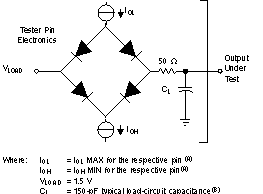SPNS155I September 2009 – June 2015 SM470R1B1M-HT
PRODUCTION DATA.
- 1 Device Overview
- 2 Revision History
- 3 Device Characteristics
- 4 Bare Die
- 5 Pin Configuration and Functions
-
6 Specifications
- 6.1 Absolute Maximum Ratings
- 6.2 ESD Ratings
- 6.3 Recommended Operating Conditions
- 6.4 Electrical Characteristics
- 6.5 Thermal Characteristics
- 6.6 ZPLL and Clock Specifications
- 6.7 RST and PORRST Timings
- 6.8 JTAG Scan Interface Timing
- 6.9 Output Timings
- 6.10 Input Timings
- 6.11 Flash Timings
- 6.12 SPIn Master Mode Timing Parameters
- 6.13 SPIn Slave Mode Timing Parameters
- 6.14 SCIN Isosynchronous Mode Timings - Internal Clock
- 6.15 SCIN Isosynchronous Mode Timings - External Clock
- 6.16 I2C Timing
- 6.17 Standard Can Controller (SCC) Mode Timings
- 6.18 Expansion Bus Module Timing
- 6.19 Multi-Buffered A-to-D Converter (MibADC)
- 7 Parameter Measurement Information
- 8 Detailed Description
- 9 Device and Documentation Support
- 10Mechanical Packaging and Orderable Information
7 Parameter Measurement Information

7.1 External Reference Resonator/Crystal Oscillator Clock Option
The oscillator is enabled by connecting the appropriate fundamental 4–10 MHz resonator/crystal and load capacitors across the external OSCIN and OSCOUT pins as shown in Figure 7-2 (a). The oscillator is a single-stage inverter held in bias by an integrated bias resistor. This resistor is disabled during leakage test measurement and HALT mode. TI strongly encourages each customer to submit samples of the device to the resonator/crystal vendors for validation. The vendors are equipped to determine what load capacitors will best tune their resonator/crystal to the microcontroller device for optimum start-up and operation over temperature/voltage extremes. Please note that external crystal mode is specified to function only within the temperature ranges of –40°C to 150°C. Above this recommended temperature range it is strongly recommended to use an external clock signal as shown in Figure 7-2 (b).
An external oscillator source can be used by connecting a 1.8-V clock signal to the OSCIN pin and leaving the OSCOUT pin unconnected (open) as shown in Figure 7-2b.
